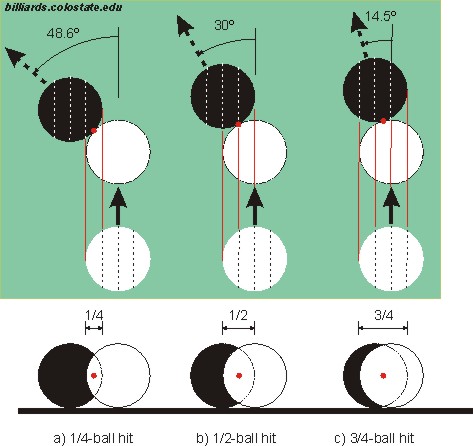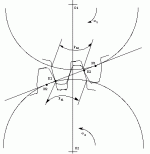You are using an out of date browser. It may not display this or other websites correctly.
You should upgrade or use an alternative browser.
You should upgrade or use an alternative browser.
Interesting thing about half ball hits
- Thread starter nrhoades
- Start date
Oh, I can't resist...
"One is the result of the other?" (The former is the result of the latter?)
J/K,
-Sean
A 1/2 ball aim is 30 degrees.
A 1/2 ball hit is 45 degrees.
randyg
A 1/2 ball aim is 30 degrees.
A 1/2 ball hit is 45 degrees.
randyg
I know, Randy -- I just took the opportunity for a little levity. This thread needs it.
But glad you answered the question, for the sake that your question wasn't flapping in the wind for gosh-knows-how-long.
-Sean
How can a 45-degree cut shot be regarded as "half-ball" anything?A 1/2 ball aim is 30 degrees.
A 1/2 ball hit is 45 degrees.
randyg
If a 1/2 ball aim does not result in a 1/2 ball hit what aim does result in a half ball hit?
THATS CALLED NO BALL HIT!!!!!!:rotflmao1:
If you aim to send the center of the CB through the edge of the OB (i.e., along the CTE line), then you are visualizing a "1/2-ball aim." A "1/2-ball hit" is what you get when you sight and align the cue along the desired line and deliver the stroke reliably with the desired tip contact point to actually send the CB to the necessary ghost-ball position to create at 30-degree cut angle (a 1/2-ball hit).
Or are you implying something else?
Regards,
Dave
Dave,
You demonstrate that depending on the hit with and without CIT the CTE aim doesn't always result in a perfect 30 degrees like on paper.
http://billiards.colostate.edu/threads/throw.html#answers
Thanks:thumbup:
That's news to me. How do you explain that one?A 1/2 ball hit is 45 degrees.
randyg
Here's an illustration from my ball-hit fraction resource page:

Using conventional terminology, a 45-degree cut angle is actually closer to a 1/4-ball hit.
Regards,
Dave
I guess this depends on how you define "cut angle." I like to think of it as the angle between the CB direction (AKA "aiming line") and the line of centers (AKA "impact line"). Throw (CIT or SIT) can be in either direction relative to the line of centers, creating a wide range of possible "effective cut angles" for a given "geometric cut angle." But that's getting nit-picky and bogged down in semantics. How about this instead: A 1/2-ball hit with gearing outside English creates a 30-degree cut angle.Dave,
You demonstrate that depending on the hit with and without CIT the CTE aim doesn't always result in a perfect 30 degrees like on paper.
http://billiards.colostate.edu/threads/throw.html#answers
Regards,
Dave
I guess this depends on how you define "cut angle." I like to think of it as the angle between the CB direction (AKA "aiming line") and the line of centers (AKA "impact line"). Throw (CIT or SIT) can be in either direction relative to the line of centers, creating a wide range of possible "effective cut angles" for a given "geometric cut angle." But that's getting nit-picky and bogged down in semantics. How about this instead: A 1/2-ball hit with gearing outside English creates a 30-degree cut angle.
Regards,
Dave
Dave,
I concur, so one needs to practice using outside english to effect "gearing" for all angles to achieve paper angle geometry...if that's desired once the angles on the table (pocket to pocket, pocket to diamonds and diamonds to diamonds etc.) are memorized.
Thanks.
Dave,
Speaking of SIT, is the effect of Spin Induced Throw from a ball spinning to the right really any different then a ball spinning to the left hitting the same spot? I would suspect that the static coefficient of friction between the balls applies to "zero left or right english" shots. But if the ball IS spinning and it collides with another ball, the "kinetic" coefficient of friction will apply, regardless of which direction the ball surfaces are moving relative to each other, and regardless of how fast. This would mean that the same gearing occurs for outside English as it does Inside english. Because the static COF is less than the kinetic COF, any spin on the ball will REDUCE throw, regardless of the spin direction.
Is this incorrect?
Dave,
Speaking of SIT, is the effect of Spin Induced Throw from a ball spinning to the right really any different then a ball spinning to the left hitting the same spot? I would suspect that the static coefficient of friction between the balls applies to "zero left or right english" shots. But if the ball IS spinning and it collides with another ball, the "kinetic" coefficient of friction will apply, regardless of which direction the ball surfaces are moving relative to each other, and regardless of how fast. This would mean that the same gearing occurs for outside English as it does Inside english. Because the static COF is less than the kinetic COF, any spin on the ball will REDUCE throw, regardless of the spin direction.
Is this incorrect?
The effect is not "gearing."
That's all I remember about what the science guys said during this discussion from years ago on RSB.
Carry on.
Lou Figueroa
Check out some of the articles and summaries on my throw resource page. I would try to quote some of it here, but the amount of information is far too voluminous. Of particular interest to you might be the throw effects summary (see items 15-35 with the supporting articles, videos, and links).Dave,
Speaking of SIT, is the effect of Spin Induced Throw from a ball spinning to the right really any different then a ball spinning to the left hitting the same spot? I would suspect that the static coefficient of friction between the balls applies to "zero left or right english" shots. But if the ball IS spinning and it collides with another ball, the "kinetic" coefficient of friction will apply, regardless of which direction the ball surfaces are moving relative to each other, and regardless of how fast. This would mean that the same gearing occurs for outside English as it does Inside english. Because the static COF is less than the kinetic COF, any spin on the ball will REDUCE throw, regardless of the spin direction.
Is this incorrect?
With gearing outside English, there is no sliding or friction whatsoever between the balls, and there is absolutely no throw. With spin amounts close to gearing, there is sliding to begin with, but the sliding ceases during ball contact and the balls then "gear" together with no sliding. With inside English, there is almost always sliding during the entire contact period, and the amount of friction and throw will be less than with outside English or no English, in most cases.
I hope that helps. If not, check out the linked resources.
Regards,
Dave
Lou,
Sorry, you are right. Gearing is the wrong word.
"Flinging" is more appropriate. Spin doesn't "fling" a ball off of its path, but CIT does.
...for cut shots greater than 45 degrees.
Right?
hmmmm, I don't think that's right either.
Without going back and reading all of Ron Shepard's most excellent "Amateur Physics for the Amateur Pool Player" here's a link to a discussion that may explain it:
http://goo.gl/mhaEG
Lou Figueroa
Check out some of the articles and summaries on my throw resource page. I would try to quote some of it here, but the amount of information is far too voluminous. Of particular interest to you might be the throw effects summary (see items 15-35 with the supporting articles, videos, and links).
With gearing outside English, there is no sliding or friction whatsoever between the balls, and there is absolutely no throw. With spin amounts close to gearing, there is sliding to begin with, but the sliding ceases during ball contact and the balls then "gear" together with no sliding. With inside English, there is almost always sliding during the entire contact period, and the amount of friction and throw will be less than with outside English or no English, in most cases.
I hope that helps. If not, check out the linked resources.
Regards,
Dave
OK I will. Thanks dave
Regardless of the cut angle, different amounts and directions of spin can throw the OB is either direction relative to the line of centers. See the following videos for demonstrations and explanations:Spin doesn't "fling" a ball off of its path, but CIT does.
...for cut shots greater than 45 degrees.
Right?
HSV B.18 - spin-induced throw speed and English effects
HSV B.30 - cut-induced and spin-induced throw and spin transfer
HSV B.33 - outside English gearing, and cut and spin-induced throw
HSV B.30 - cut-induced and spin-induced throw and spin transfer
HSV B.33 - outside English gearing, and cut and spin-induced throw
and see the articles and info here:
For extreme examples, see the following videos, where outside English can "fling" the ball even for a cut close to 90 degrees:
NV B.92 - "Impossible" cut shots, from VEPS V
HSV A.142 - Vernon Elliott cross-side bank with chalk on the object ball to increase throw and spin transfer
HSV A.142 - Vernon Elliott cross-side bank with chalk on the object ball to increase throw and spin transfer
Regards,
Dave
QUOTE=[lfigueroa;3330138]The effect is not "gearing."
That's all I remember about what the science guys said during this discussion from years ago on RSB.
Carry on.
Lou Figueroa[/QUOTE]
The term gearing is discriptive of what happens when the rotation of the CB is in sync with the OB wiithout "spinning" the OB with friction transferred by the CB.
 [
[
That's all I remember about what the science guys said during this discussion from years ago on RSB.
Carry on.
Lou Figueroa[/QUOTE]
The term gearing is discriptive of what happens when the rotation of the CB is in sync with the OB wiithout "spinning" the OB with friction transferred by the CB.
 [
[I know, Randy -- I just took the opportunity for a little levity. This thread needs it.
But glad you answered the question, for the sake that your question wasn't flapping in the wind for gosh-knows-how-long.
-Sean
Sean, if you are agreeing with Randy that "A 1/2 ball hit is 45 degrees," please explain what you (and Randy) mean by that.
Sean, if you are agreeing with Randy that "A 1/2 ball hit is 45 degrees," please explain what you (and Randy) mean by that.
AtLarge:
I was quickly agreeing with Randy on the simple concept that a 1/2 ball aim is not necessarily a 1/2 ball hit, purely for parallax purposes, not the 45-degree angle thing. You can look at the shot different ways, but unless your field of vision is perfectly centered, "what you see isn't necessarily what you get."
I agree with Dr. Dave that the 45-degree cut is more of a 1/4-ball hit. That's just basic geometry with spheres. I would also be interested in hearing Randy's explanation of why he feels a 45-degree cut angle is a half-ball "hit."
-Sean